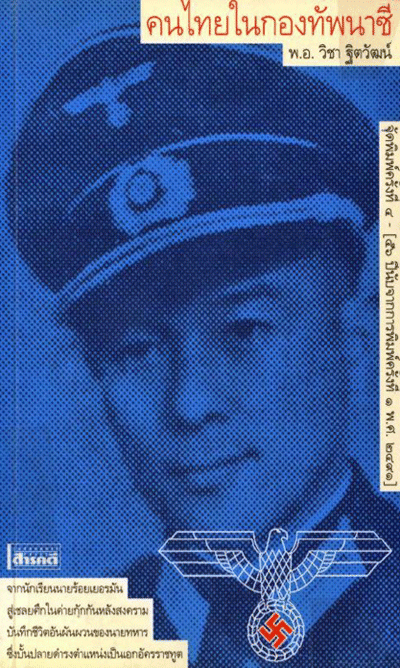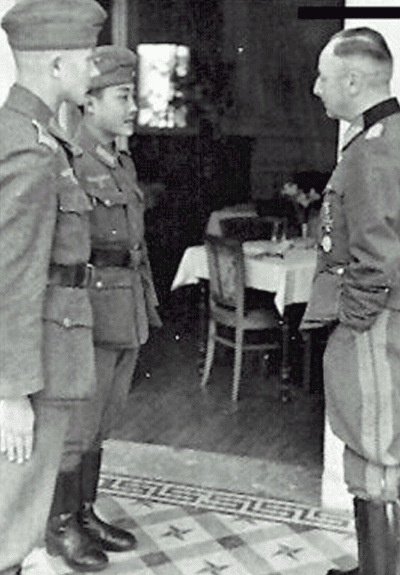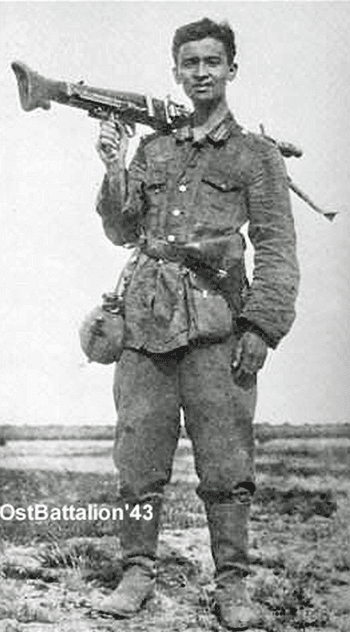A Thai in the German Wehrmacht

In 1936 he had enrolled at the Military Academy in Bangkok and two years later this aspiring officer, together with another fellow student, was sent to Belgium to study military communication systems at the Military School in Brussels. Surprised by the German invasion of May 1940, he could not immediately return to Thailand and for reasons that are not entirely clear to me, he suddenly turned up a few months later in a German military school. In itself this was not so strange because already from the end of the 19e century, at the request of King Chulalongkorn, Thai candidate officers were sent to European military schools for further training. However, it is not clear whether his compatriot, who had been sent to Brussels with him, had also gone to Germany.
As mentioned, Wicha Thitwat started studying at the Military Academy in Berlin, but less than a year later he voluntarily enlisted as funker or radio operator in the 29e Panzer Grenadier Division of the German Wehrmacht. A few months after his enlistment, he was transferred to the 3e Panzer Grenadier Division. In all likelihood, this happened with the – tacit – agreement of the Thai government at the time, because after all he was not only a Thai national but also a Thai aspiring officer and accountable as such…
In early 1942, he mutated into a unit that would become known as East Battalion 43. A unit under German command formed exclusively with Asians: At least 300 Japanese were part of this unit. Logical, because Japan had been an ally of Germany since 1938. Most of these soldiers from the Land of the Rising Sun were students at various military academies in Germany at the outbreak of the war and enlisted voluntarily. Following in the footsteps of the Japanese, several hundred Koreans and Mongols who came from Manchuria also followed. Korea had been occupied by Japan since 1909 and Manchuria since 1931.

The remaining men in this unit were Asians captured in the ranks of the Red Army and recruited from POW camps. Although most of these former prisoners of war later returned to their own, ethnically composed Eastern Battalions would end up. For example, there were units for Kyrgyz, Kalmoek and Ossetians. East Battalion 43 was deployed from mid-1943 against the Red Army and in fighting partisans operating in the back of the German army. In the absence of the book I can say little about Whicha Thitwat's career, but he may have made it to officer because in at least one photo he wears the shoulders of a 'Führerbewerber', a candidate officer. In any case, he survived the war and after his return to Thailand he became a colonel in the Thai army. In the XNUMXs, Whicha Thitwat was a Thai military attache seconded successively to the Thai embassies in Denmark, Norway and Iceland.
According to Whicha Thitwat, several dozen Thais served in the German army during World War II. Until I can get my hands on his book, I have only been able to find one other and then he was still of 'mixed' origin. Lucien Kemarat's mother was French, his father was a Thai from Isaan, who probably arrived in what was then Indochine via an intermediate stop. la douce France had gotten lost. Almost immediately after most of France was occupied, the then 18-year-old Kemarat tried to enlist in the Waffen SS as a war volunteer. His candidacy was rejected on racial grounds, so in 1941 he engaged in the Legion Volontaire Français (LVF), a volunteer legion created by French collaborators to work with the Wehrmacht to fight on the Eastern Front. In the ranks of the LVF there were much less strict conditions and he was immediately allowed the feldgray put on a coat of arms. Originally trained as a scout, he eventually became the first gunner of the MG heavy machine gun
42. Kemarat was wounded and taken prisoner of war by the Soviets in early 1943 but managed to escape and rejoin his unit. In the summer of 1943 the LVF was transformed into the 'Sturmbrigade Frankreich' and incorporated into the Waffen SS where this unit would become infamous as the Waffen SS Panzergrenadier Division 'Charlemagne' who, together with Dutch, Norwegian and Danish SS volunteers, died in 1945 to the last man Reich Chancellery defend in Berlin.
Panzergrenadier Kemarat, who eventually ended up with the Waffen SS, was assigned to the 10e (anti-tank) company of the Infantry Regiment No. 58. The Germans needed cannon fodder and Asian blood was apparently no longer an obstacle for the Waffen SS. He survived the heavy anti-aircraft battles in Ukraine, Pomerania and on the Oder. With several hundred survivors of the Infantry Regiment No. 58 he tried to escape to Denmark but on 2 May 1945 this unit surrendered to the British. It is not clear whether Lucien Kemarat was taken prisoner or whether he escaped in civilian clothes. It is certain that he returned to France after the war. According to my old comrade, the Norman military historian Jean Mabire, he was alive at least until the early 2000s, and in 1973-1974 had contributed to the writing of his book 'La Division Charlemagne: les combats des SS français en Poméranie'....



Try searching by image
https://support.google.com/websearch/answer/1325808?co=GENIE.Platform%3DAndroid&hl=nl
very interesting story.
is there or are there any more stories and details please post
Interesting story, Lung Jan. It was of course true that in those years Thailand under the leadership of Prime Minister Field Marshal Plaek Phibunsonghraam felt more or less an ally of Japan, Italy and Germany. Could that have been one of the reasons that the said Thais fought with the Germans? Or did the adventure beckon?
Dear Tina,
To say that Phibunsongkhram felt 'more or less' an ally of the Axis powers is an understatement. As early as December 14, 1941, less than a week after the Japanese invasion of Thailand, he signed a secret treaty in which he committed himself to provide military assistance to a Japanese invasion of Burma, which was then in British hands. A week later, the Thai-Japanese alliance was already official when Phibun signed a military cooperation agreement at Wat Phra Kaeo in Bangkok. In return, Japan promised to guarantee Thai sovereignty and independence. Thailand was not considered an occupied territory and the Thai armed forces were not disarmed…
As for the motives, I'm in the dark there. Just maybe, if I ever find this book, I can find an answer in it...
Interesting story. With regard to “foreigners” in the German Wehrmacht, I am no longer surprised at all, whether it concerns Irish or Americans, Englishmen in the British Freikorps or an Indo-Dutch in the Afrikakorps. But a Thai is quite exceptional.
Perhaps the (slightly chaotic and not always accurate) study The east came west can shed some light on the issue in general? I know that in this collection of articles (it seems like a serious study, but the quality is sometimes mediocre) there are different population groups, nationalities and their Werdegang and inclusion in the German army.
Incidentally, the Waffen-SS was not very unequivocal in including 'non-Aryans': men from eg the Indisch Legion were included in the Waffen-SS, but not in the SS. The consequences? A small part received an SS uniform, but was not allowed to call itself an SS officer. It wouldn't matter much to most people. They were also not given the same privileges as other Waffen-SS men should Germany win the war.
@Alex There was indeed a distinction within the Waffen-SS. This can be deduced, for example, from the names of the various units. For example, units that added Frw. (Freiwillige) had already considered them "lesser" than tribal units such as Leibstandarte and Totenkopf, but units that were known as "Waffen Grenadier Division der SS" were certainly not seen as fully-fledged Waffen-SS divisions. However, it was necessary to include them in the Waffen-SS, since the Wehrmacht was traditionally very reluctant to include non-Reichsdeutsch in their ranks.
Thanks again Jan. The photo accompanying this article looked familiar to me, and yes, in a note from early 2017 I have his name and a photo. No idea how or why, first thought through this blog but no because 1) no further results found 2) I don't think you wrote here yet (?) at the beginning of 2017.
Incidentally, Wicha Thitwat will undoubtedly have a 'Personal Certificate', or a file with his progress, deployment, awards and military training. That file is either present in Freiburg or in Berlin. An overview can of course be requested (with a waiting period of approximately two years!) via the WASt Dienststelle.
Dear Lung Jan,
The title of the book is คนไทยในกองทัพนาซี (Thai in the Nazi Army) and check this link for the book http://dl.parliament.go.th/handle/lirt/333884
Or maybe there is a pdf version somewhere.
Of course I don't have this wisdom of my own, but such a story has served the purpose of taking a closer look at what kind of guy that was and then here's the picture of him:
http://www.warrelics.eu/forum/attachments/photos-papers-propaganda-third-reich/1286933d1551630281-show-your-signed-photos-wichathitawatthai.png
His name would now be Wicha Thitwat but at the time Vicha Dithavat was used.
Look up that name and I was at least a little surprised that with such a track record you can become ambassador in France without the host country objecting.
https://th.m.wikipedia.org/wiki/%E0%B8%A7%E0%B8%B4%E0%B8%8A%E0%B8%B2_%E0%B8%90%E0%B8%B4%E0%B8%95%E0%B8%A7%E0%B8%B1%E0%B8%92%E0%B8%99%E0%B9%8C
Regarding the name วิชา ฐิตวัฒน์ it is not surprising that there are differences. Just a quick lesson.
In Thailand, a foreign name is translated letter by letter and with an ei, ij, y in the name, the translation and then do not correspond at all with the Dutch pronunciation and that now also seems to happen from Thai to English with the language rules applicable at the time.
The V is not an "official" letter in the Thai alphabet so it becomes a W and the with ตวัฒน์ is pronounced tavat.
In my old note the name was written as Wicha Titawat.
When converting from Thai characters to European or vice versa, the English pronunciation is indeed often used, and the conversions are sometimes .. uh .. creative. Take the ว (w) which is transformed into a V… (which is not known in Thai).
His name is วิชา ฐิตวัฒน์, letter by letter 'wicha thitwat(ñ)', sounds like (wíechaa Thìtawát).
I come across the book with ISBN numbers 9744841389 and 9789744841384. For looking for books on sale I recommend http://www.bookfinder.com On. A search engine that searches various 1st and 2nd hand outlets.
For libraries with the book in their collection, take a look at: https://www.worldcat.org/title/khon-thai-nai-kongthap-nasi/oclc/61519408
Also searched Princess Sirindhorn Anthropological Institute's database, no match. Perhaps in a university library?
http://www.sac.or.th/en/
2nd attempt, still found at the SAC:
Title:คนไทยในกองทัพนาซี / วิชา ฐิตวัฒน์.
Author: วิชา ฐิตวัฒน์
Published: กรุงเทพฯ : สารคดี, 2547
SAC call number: DS573.3.ว62 2547 (available)
link: http://lib.sac.or.th/Catalog/BibItem.aspx?BibID=b00041628
But there are more uni/public libraries in the country that maybe Jan won't have to go to BKK. Copying books is not possible at the SAC. Wanted to copy a hard-to-find book this spring, but due to copyright you can not put more than ten pages (or 10%) under the copier. I heard from Tino that at the university library in Chiang Mai people didn't make a fuss about 1 on 1 copies via a multi-scanner. Yes, that's not good, but if a book really isn't for sale and the library isn't around the corner...
Even though we don't always agree, this is just something we make someone else happy with.
Yep, indeed Johnny. 🙂
@ Readers/Jan: According to a 2nd WorldCat page, Thammasat and Chula universities, among others, have this book in their library. But this entry is not complete either, as we see SAC is missing from that list. The book will surely be found in even more libraries. Is there perhaps a Thai website that lets you search all libraries?
https://www.worldcat.org/title/khon-thai-nai-kongthap-nasi/oclc/1042277552
Dear Johnny & Rob,
Many thanks for the useful tips gentlemen. The number of decent libraries in the corner of Isaan where I live is not really overwhelming. I may be a bit old fashioned but if I find a book interesting I usually want to own it…. It was therefore with great regret that when I moved to Thailand I had to make a selection and eventually sent a working library with about 4.000 here by container. Fortunately, my – approximately – 8.000 other books found a new home with friends and a few scientific institutions… In the meantime I have started collecting here again. but now usually limit it to Asiatica ..;.. If I find the book, I am guaranteed to share my findings on this blog ...
I have not yet been able to find an available book, but for the enthusiast there is a copy to download on the internet.
A direct link does not work so copy the following and search on Google:
archive.org คนไทยในกองทัพนาซี วิชา ฐิตวัฒน์
oops, the search term is incorrect but you should have attached the pdf http://dl.parliament.go.th/handle/lirt/333884 can get.
Nice Johnny BG and Rob V. that you looked into this further. Very nice, that's how we learn something.
About the name วิชา ฐิตวัฒน์, Wicha Thitawat (wíechaa thìtawát)
wichaa knowledge, science, can be found in many combinations. Wicha moh phie is eg witchcraft
this is always, constantly, permanently
what is full wattana development, progress.
Together his name therefore means: Knowledge Continuous Progress
La Division Charlemagne: les combats des SS français en Poméranie'…. is for sale on Amazon 17 euros